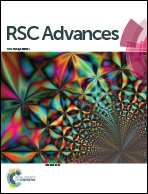Design of highly porous Fe3O4@reduced graphene oxide via a facile PMAA-induced assembly†
Abstract
Advances in the synthesis and processing of graphene-based materials have presented the opportunity to design novel lithium-ion battery (LIB) anode materials that can meet the power requirements of next-generation power devices. In this work, a poly(methacrylic acid) (PMAA)-induced self-assembly process was used to design super-mesoporous Fe3O4 and reduced-graphene-oxide (Fe3O4@RGO) anode materials. We demonstrate the relationship between the media pH and Fe3O4@RGO nanostructure, in terms of dispersion state of PMAA-stabilized Fe3O4@GO sheets at different surrounding pH values, and porosity of the resulted Fe3O4@RGO anode. The anode shows a high surface area of 338.8 m2 g−1 with a large amount of 10–40 nm mesopores, which facilitates the kinetics of Li-ions and electrons, and improves electrode durability. As a result, Fe3O4@RGO delivers high specific-charge capacities of 740 mA h g−1 to 200 mA h g−1 at various current densities of 0.5 A g−1 to 10 A g−1, and an excellent capacity-retention capability even after long-term charge–discharge cycles. The PMAA-induced assembly method addresses the issue of poor dispersion of Fe3O4-coated graphene materials—which is a major impediment in the synthesis process—and provides a facile synthetic pathway for depositing Fe3O4 and other metal oxide nanoparticles on highly porous RGO.



 Please wait while we load your content...
Please wait while we load your content...